Abstract
1. Receptive fields of colour-coded ganglion cells of the goldfish retina were investigated.
2. Only a few cells (5%, Type P) were found to be as simple as those described by Wagner, MacNichol & Wolbarsht (1960, 1963), with an `on' response to red light in the centre, and an `off' response to green light over a rather wider area, or vice versa.
3. Most cells (49%, Type O) also gave a peripheral response with an `on' response to green light, and an `off' response to red light in the periphery, as well as an `on' response to red light and an `off' response to green light in the centre (or vice versa).
4. When a small spot of light was used to stimulate the periphery of a Type O cell, the peripheral response usually was not obtained. The organization of the periphery is such that a stimulus of large area and low intensity (annulus) is much more effective than a stimulus having equal energy with small area and high intensity (spot). If only small spots are used, the Type O cell is indistinguishable from the Type P cell.
5. Spectral sensitivity measurements show that one central and one peripheral process are fed primarily by red-absorbing cones, and the other central and the other peripheral process by green-absorbing cones or rods.
6. The diameter of the receptive field as a whole is very large, being 5 mm or more on the retina.
7. When red spots in green surrounds, or red/green boundaries are used as stimuli, the response can be predicted by summing the responses to the components of the stimulus.
8. This type of receptive field organization is appropriate to mediate simultaneous colour contrast. The `opponent colour' organization previously reported is appropriate for successive colour contrast, but not for simultaneous colour contrast.
9. The component of the response coming from the green-absorbing cones was masked or hidden by the component of the response coming from the red-absorbing cones in 14% of the units (Type Q units). The component from the green-absorbing cones was revealed by using a high intensity of stimulation, or by observing the response after bleaching pigment with an intense red light.
Full text
PDF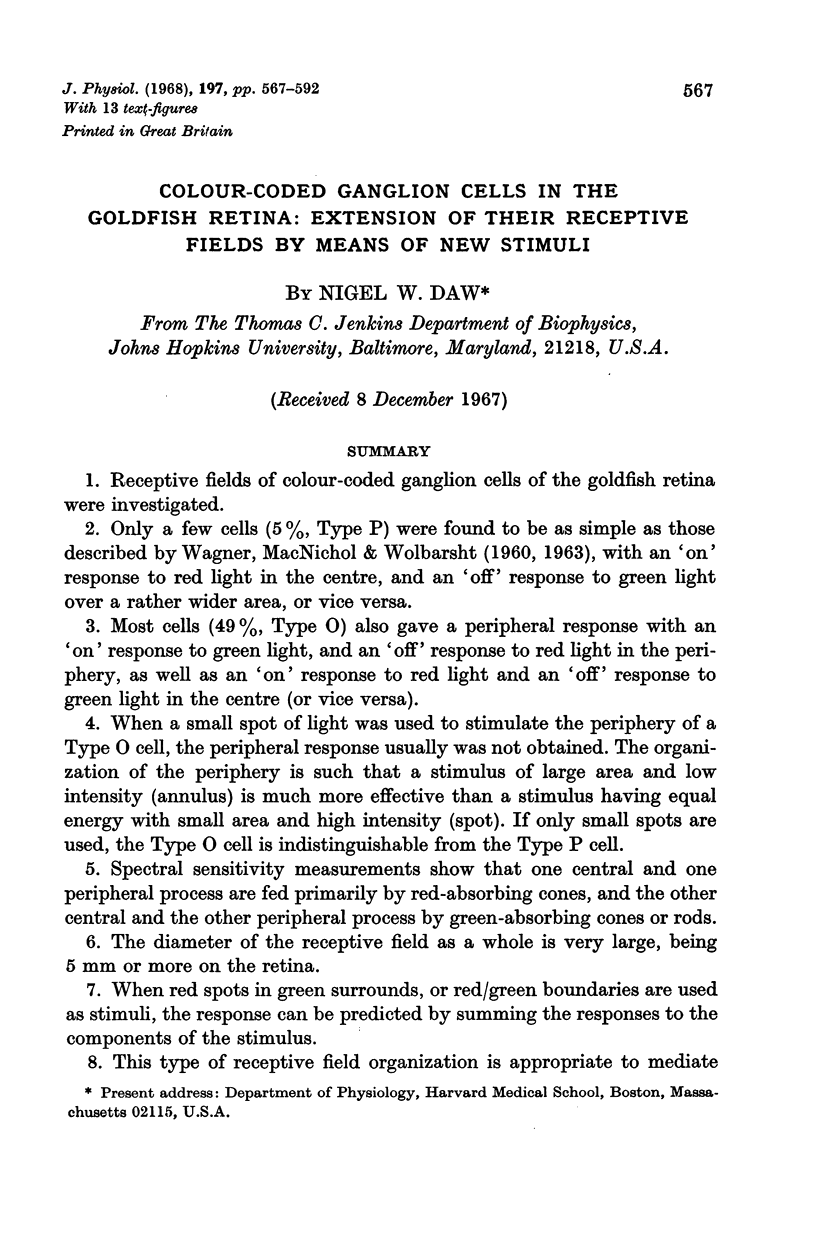

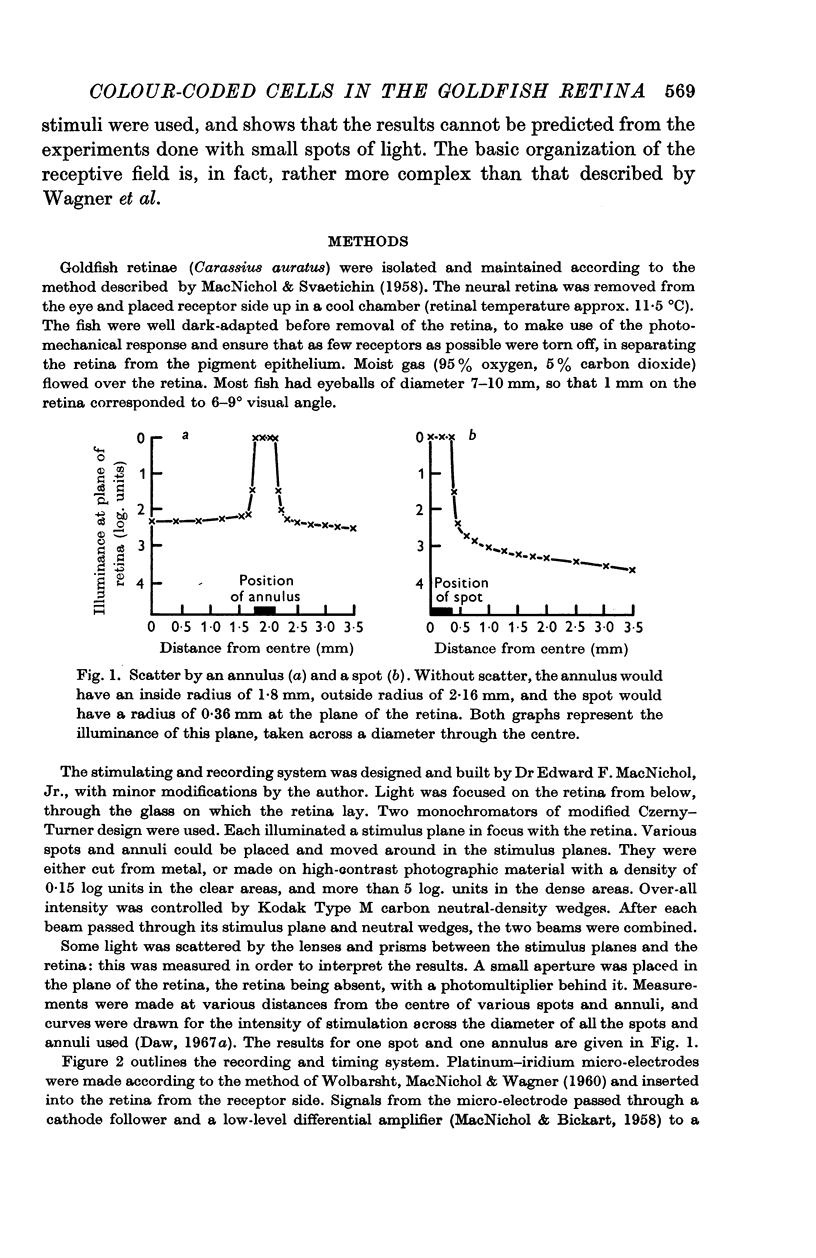
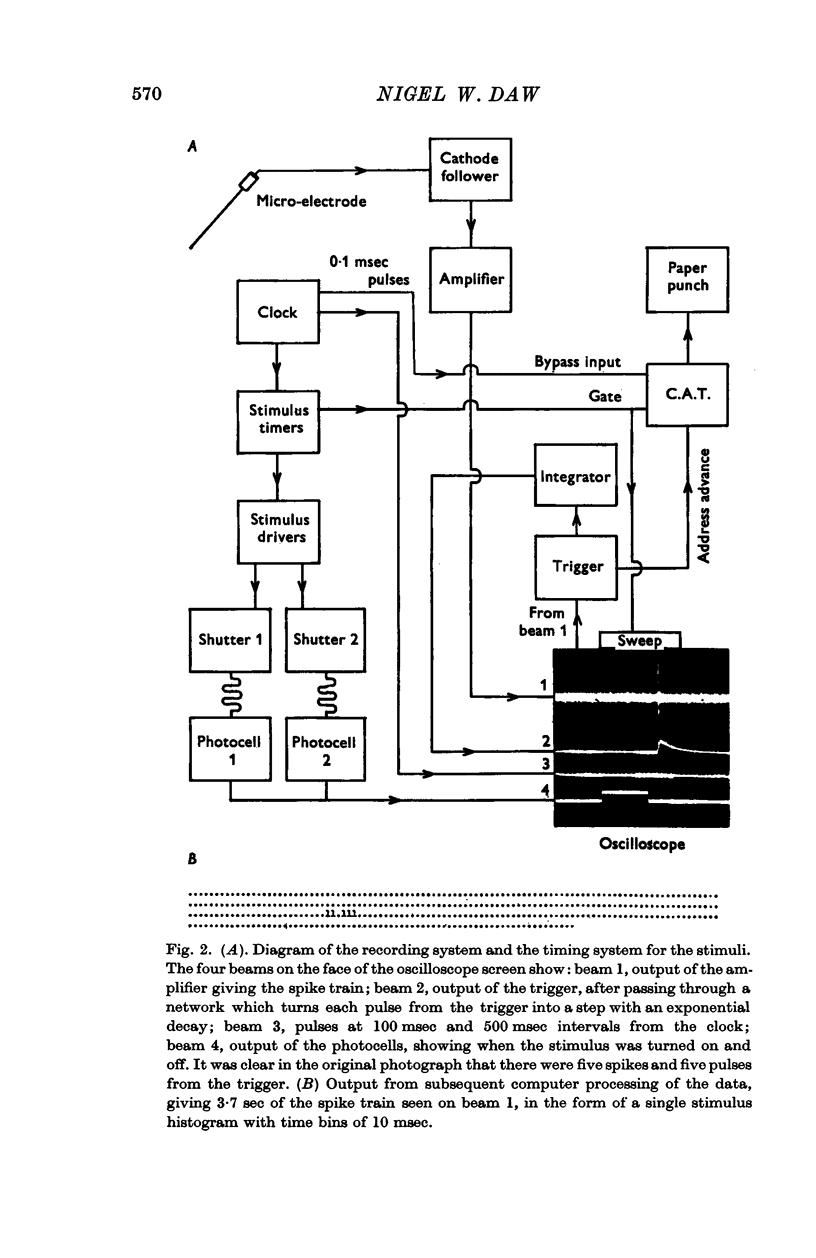
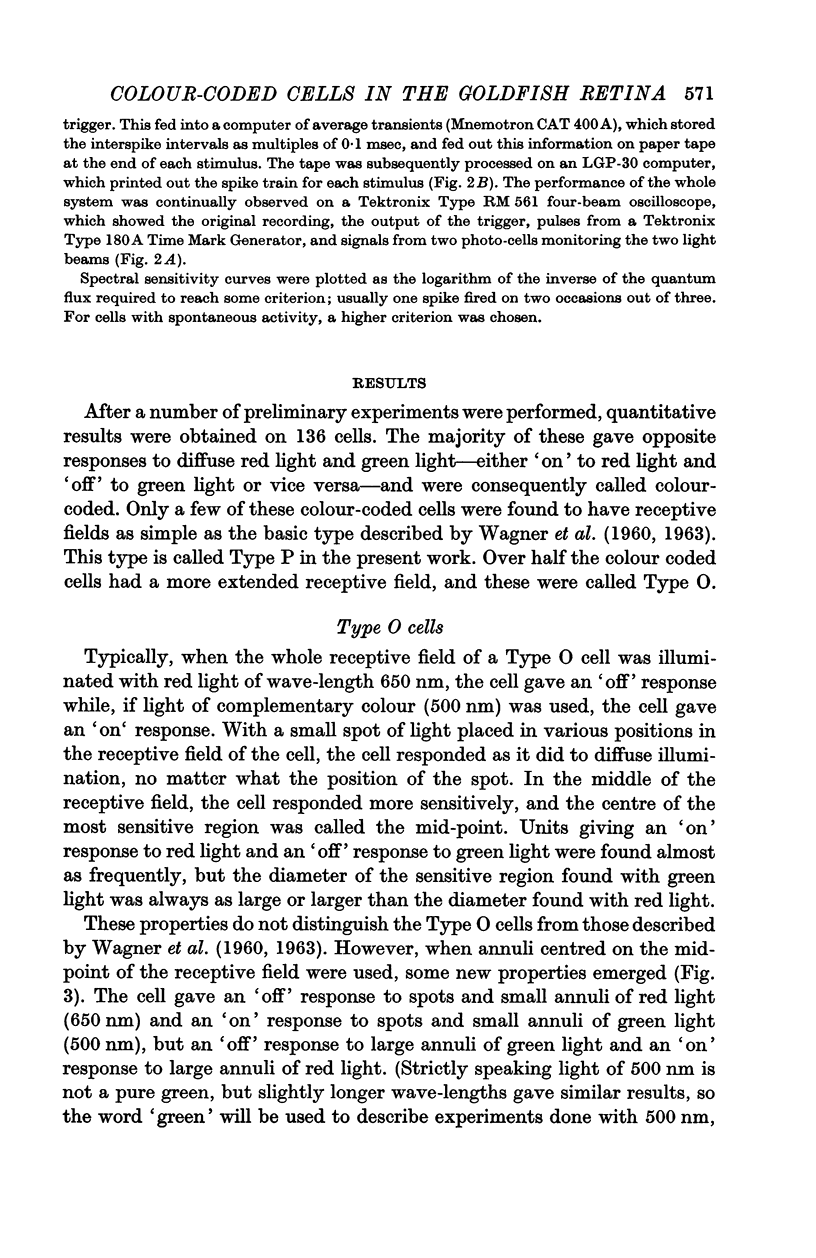
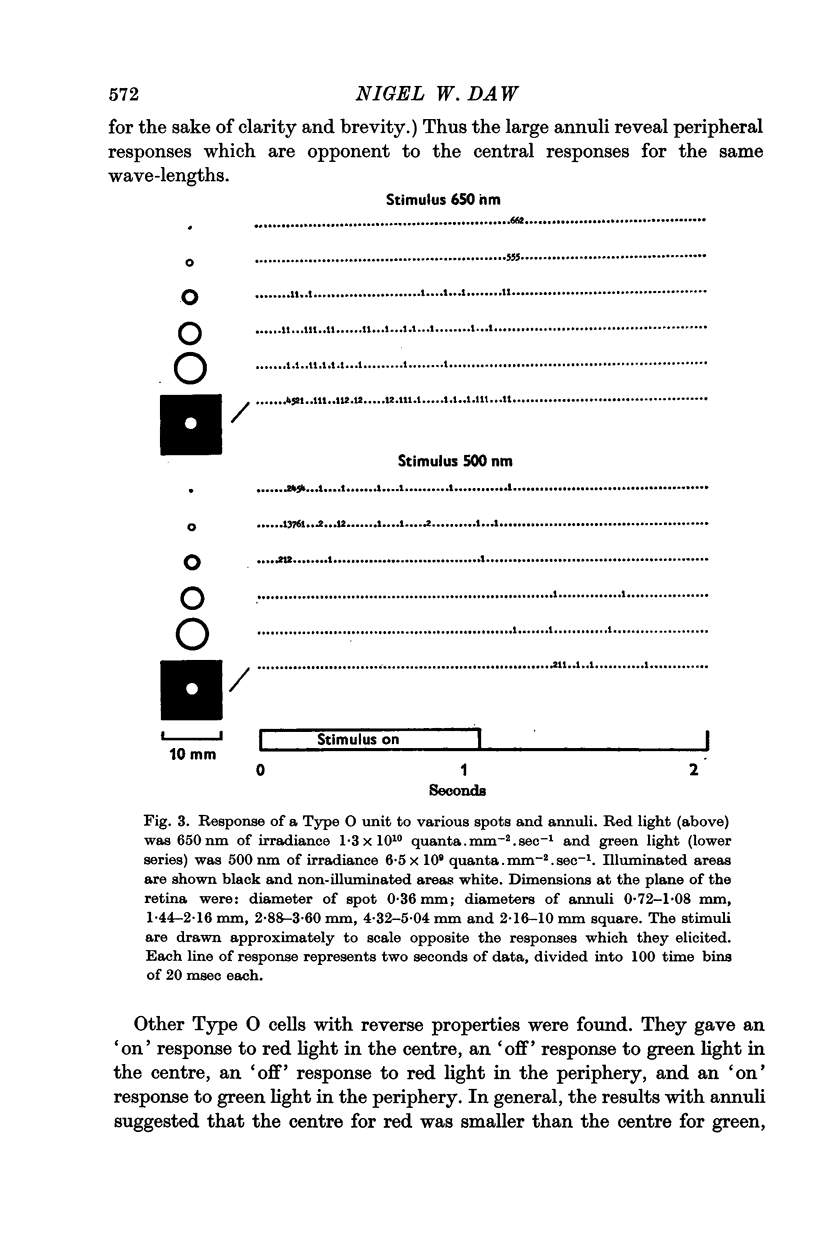
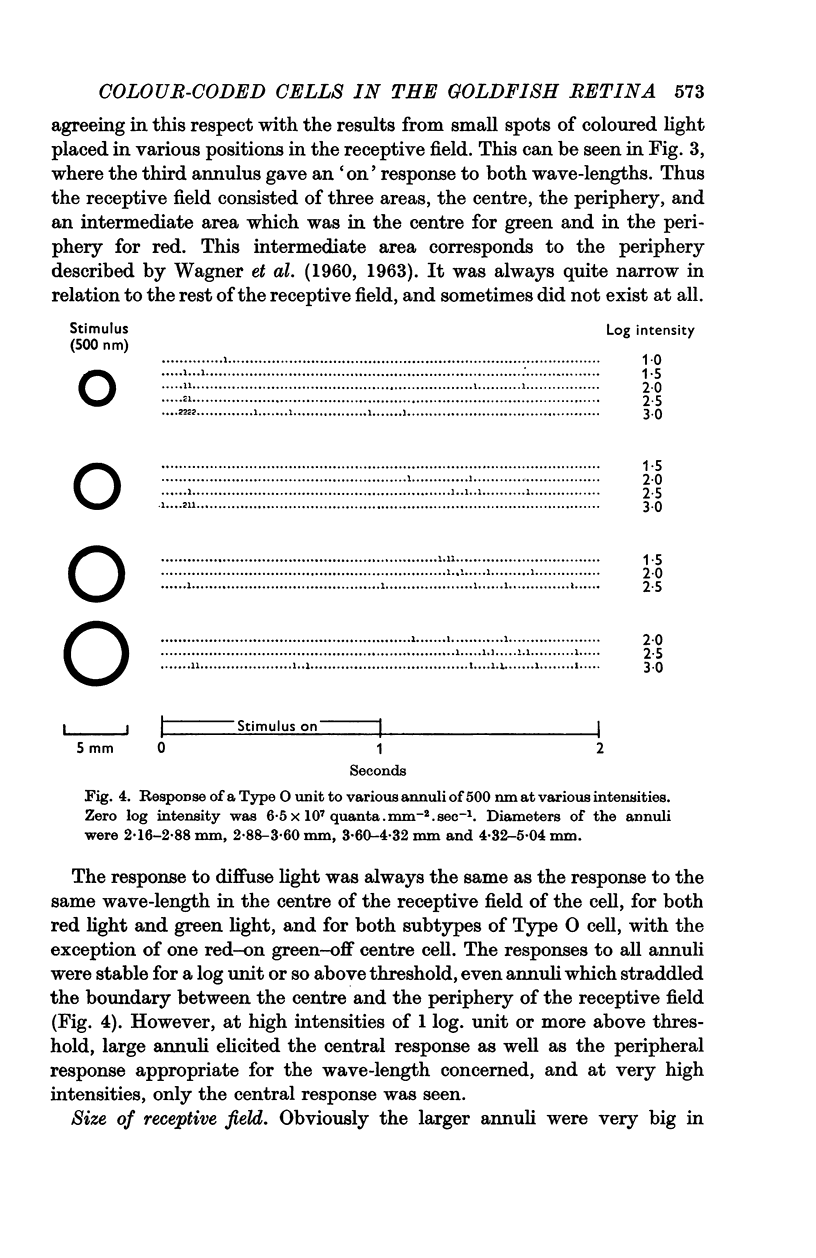
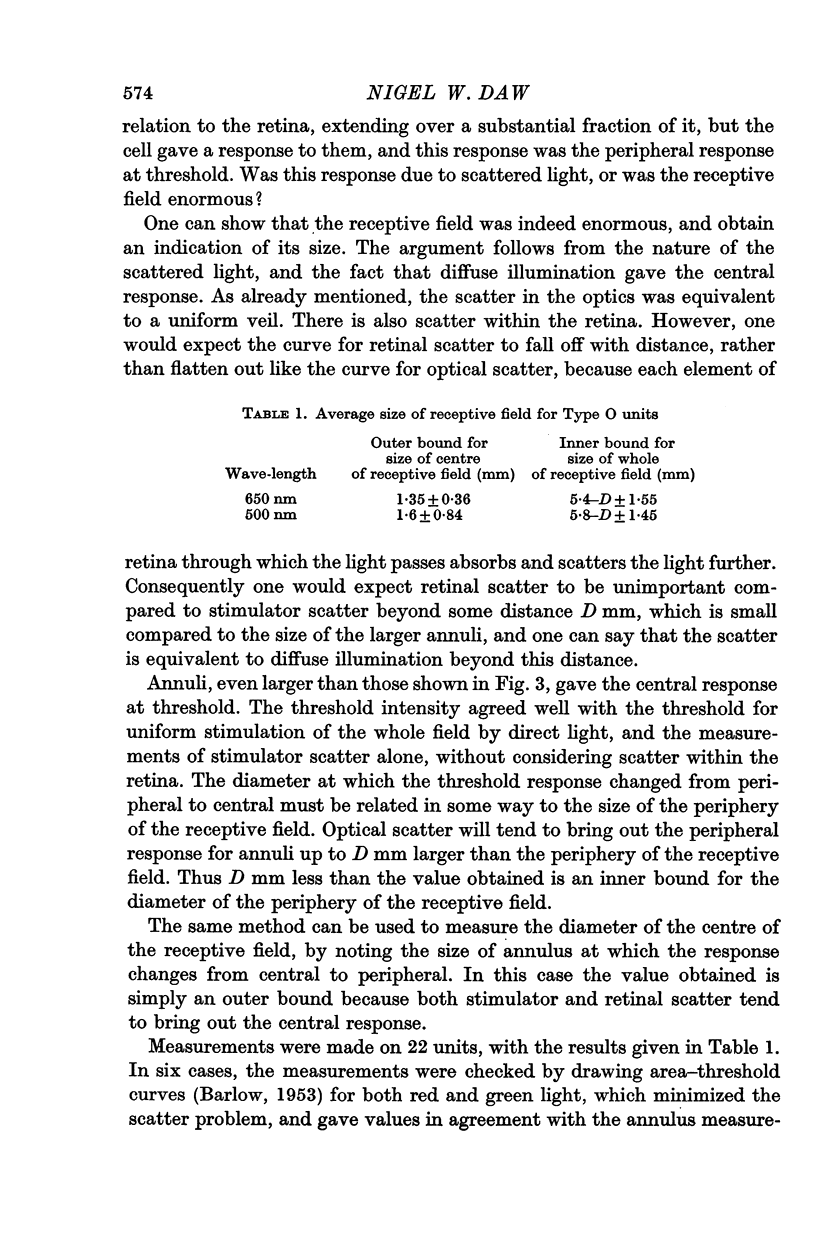
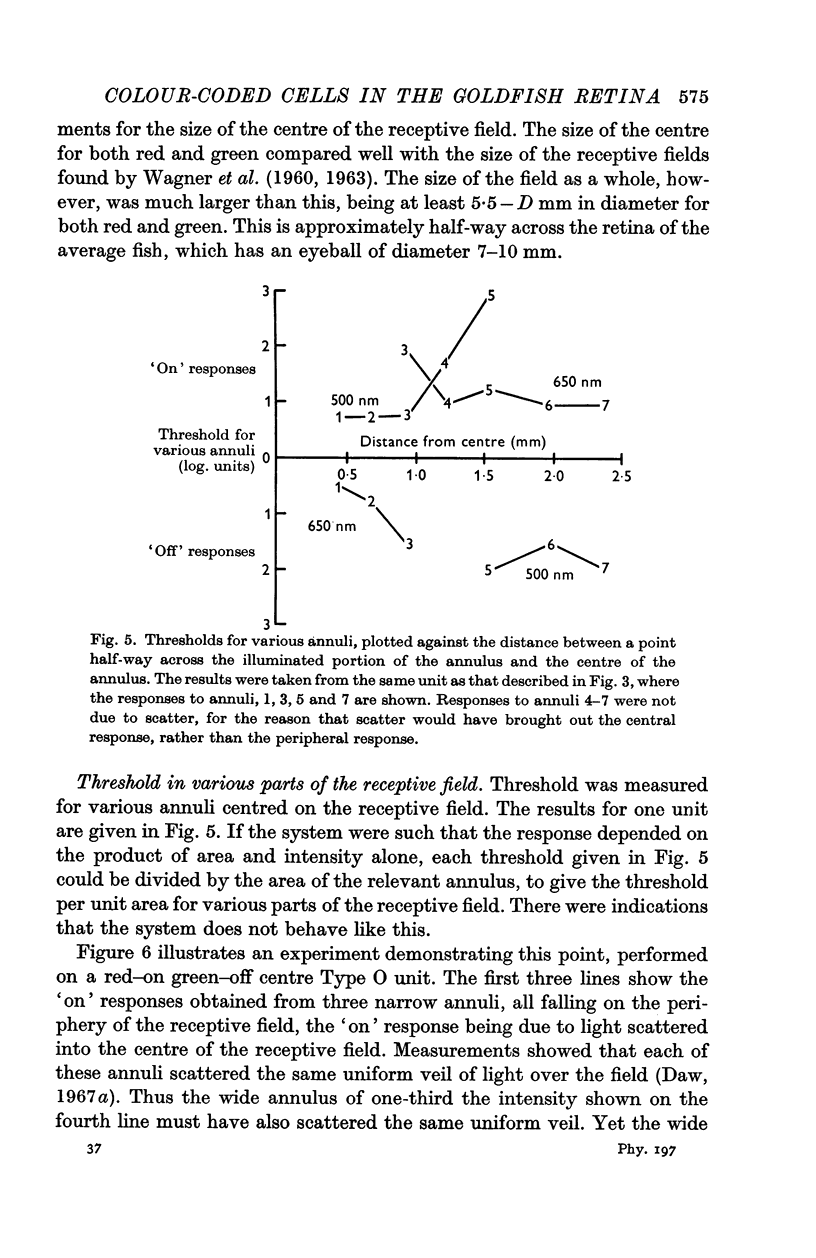
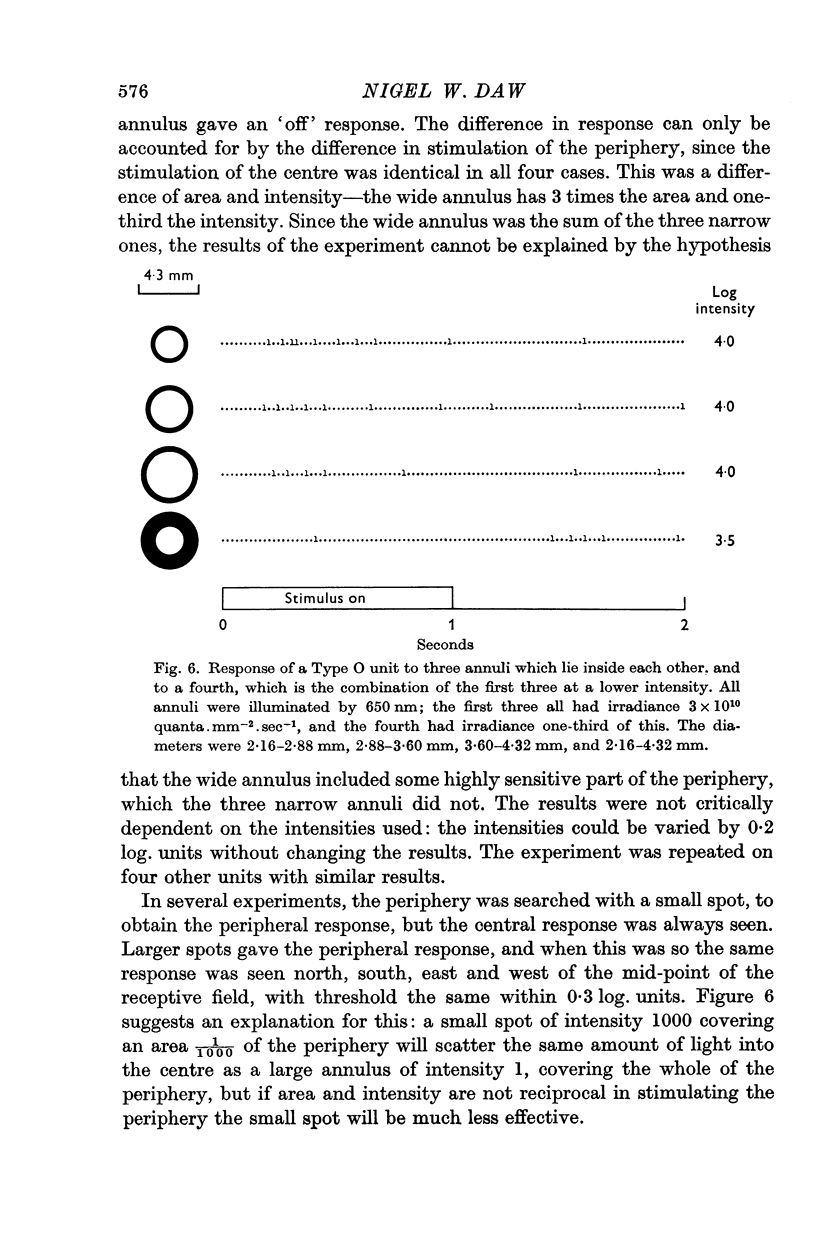
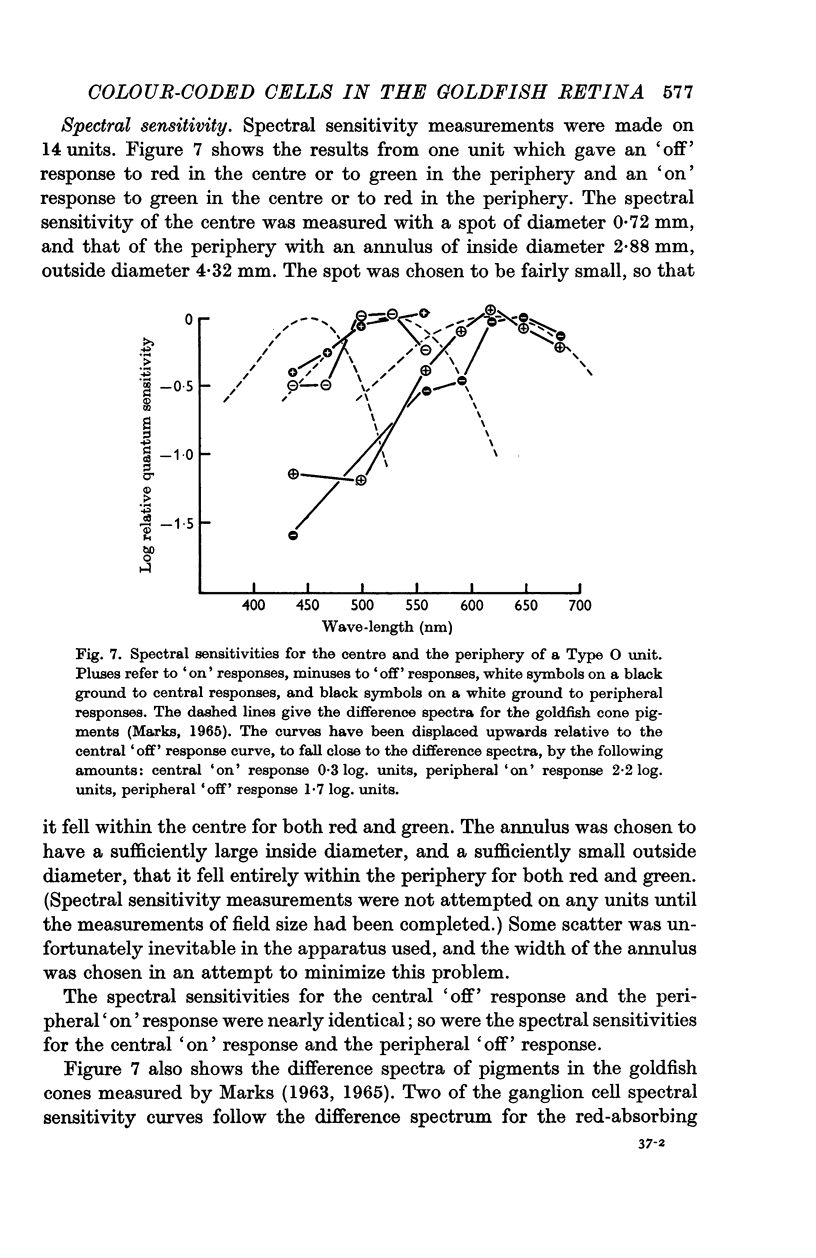
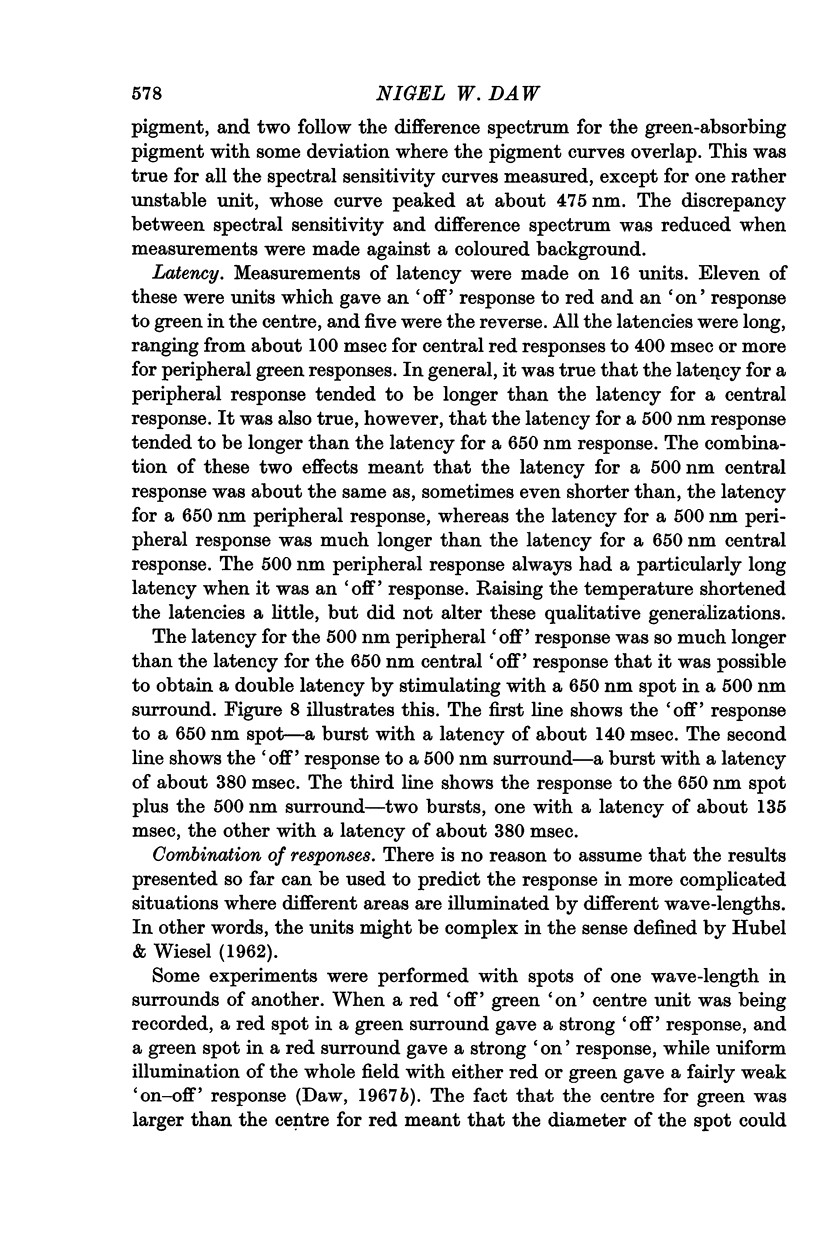
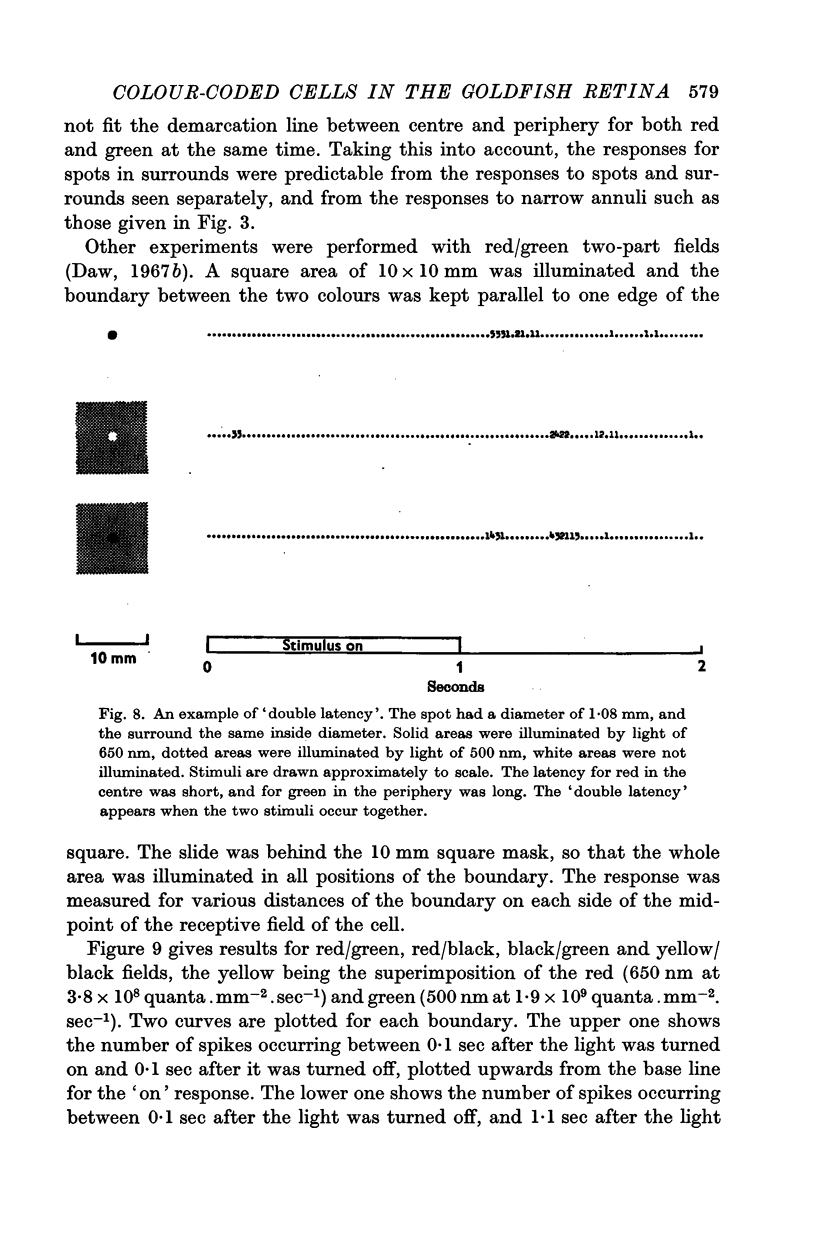
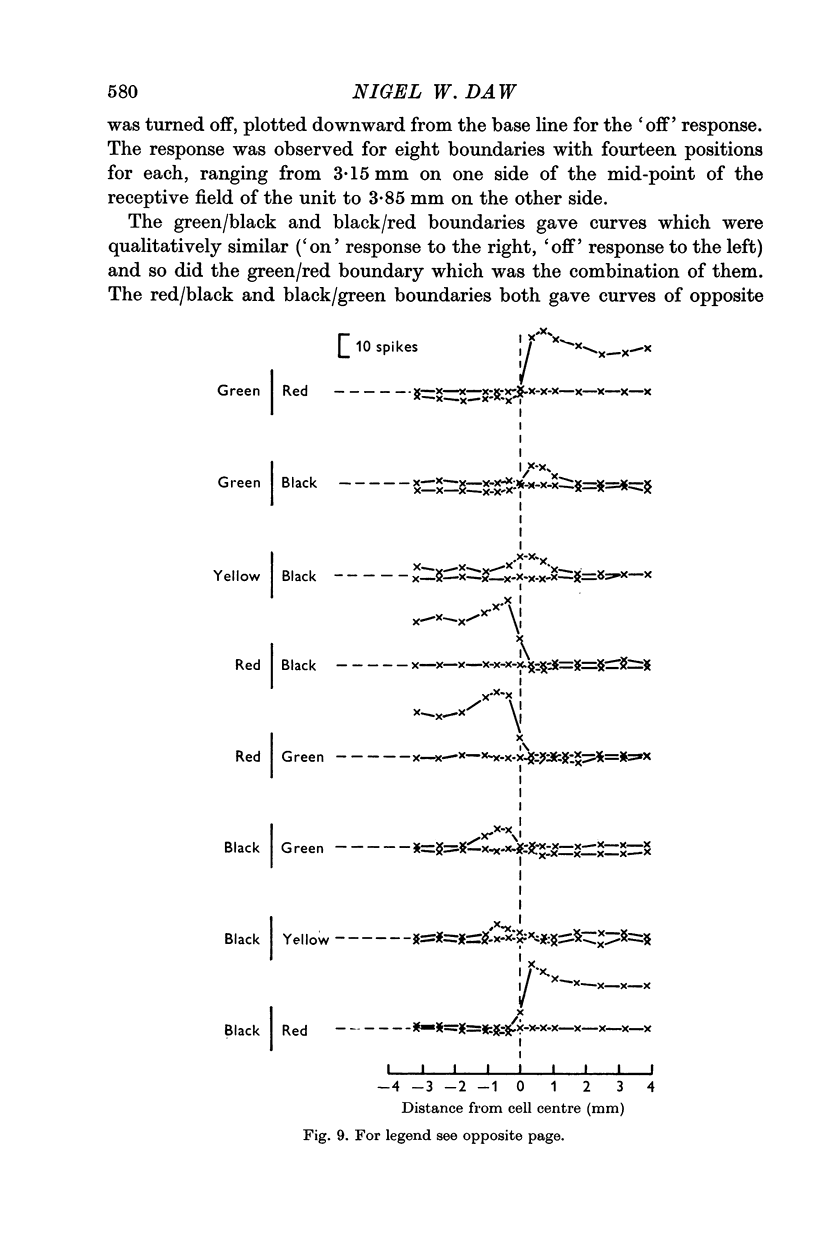
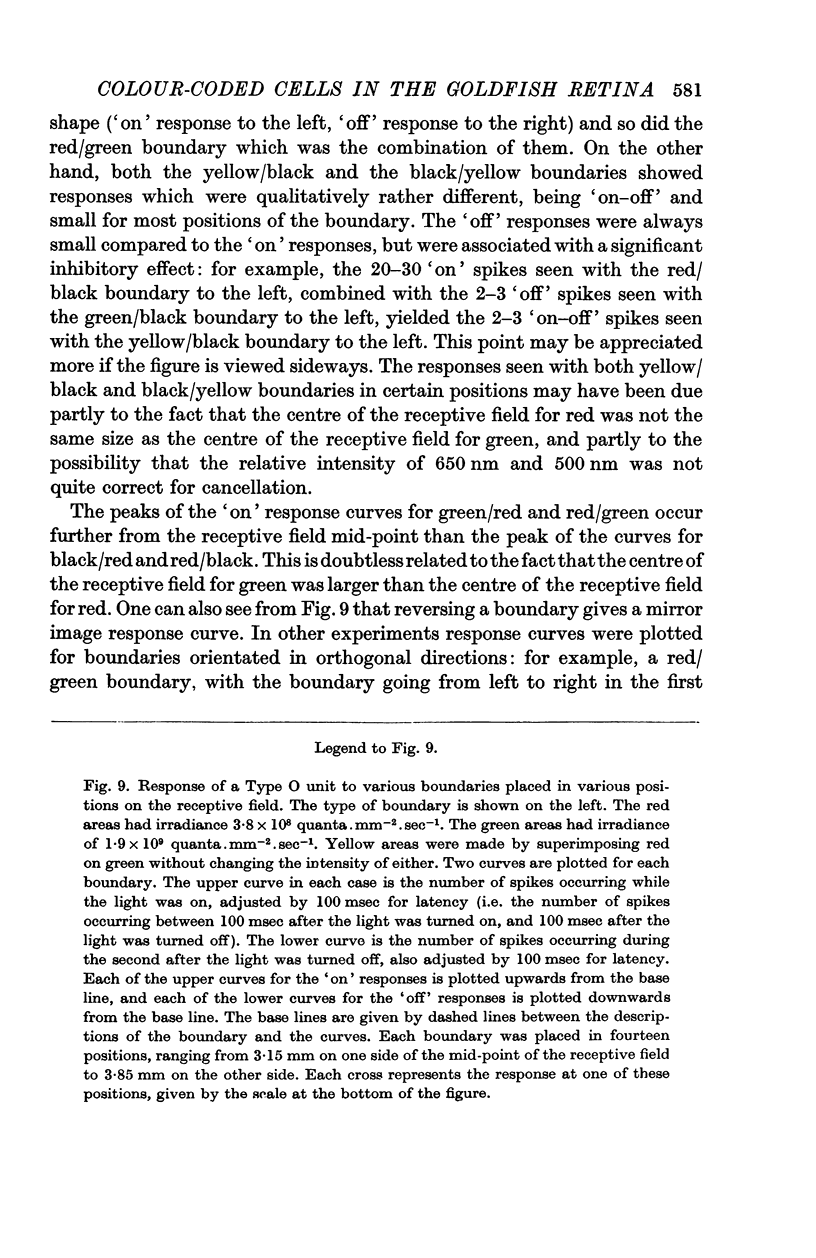
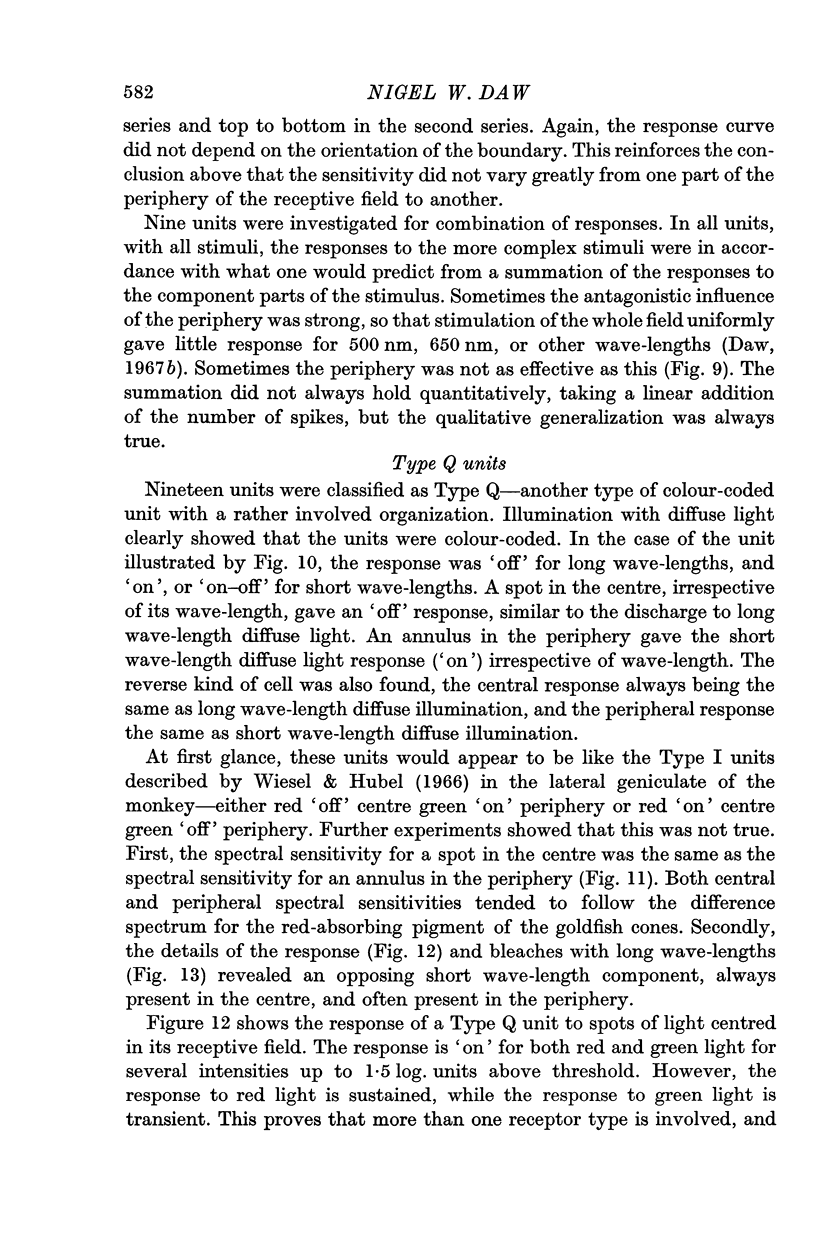
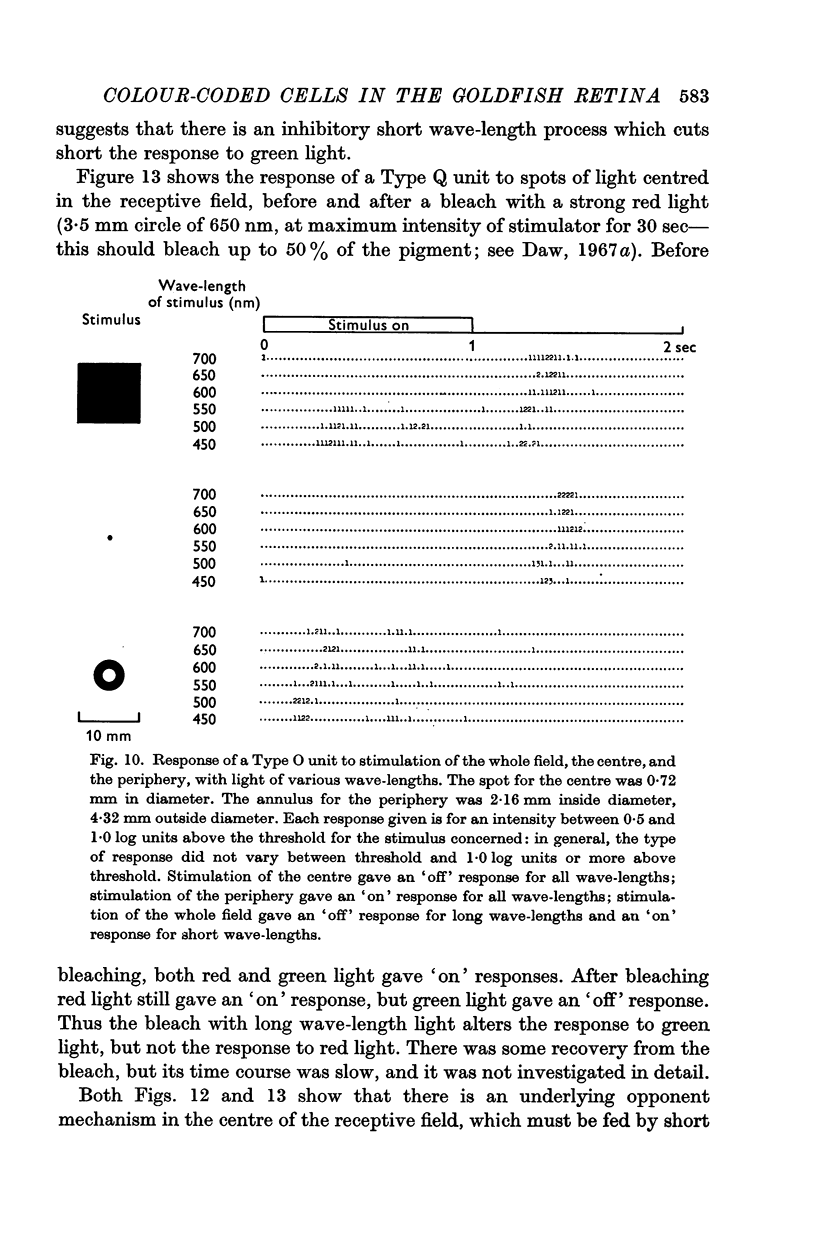
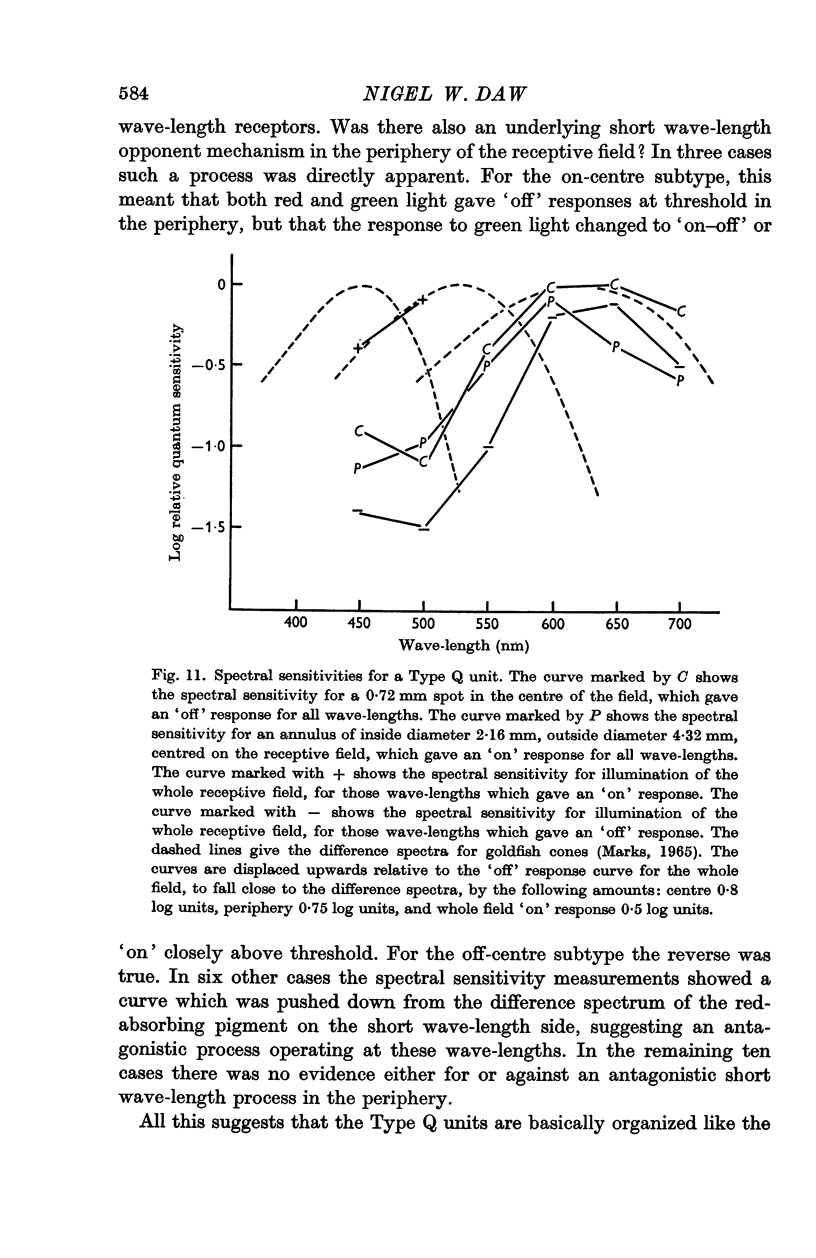

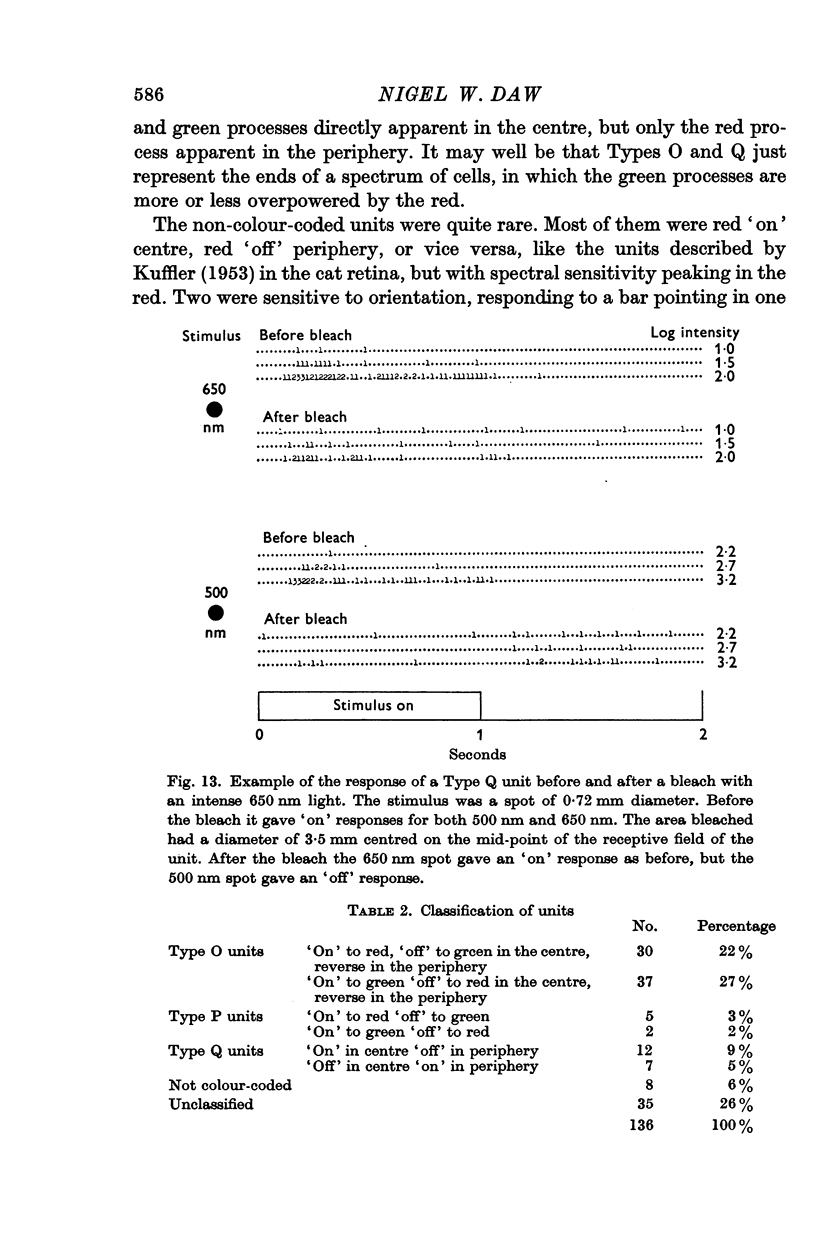
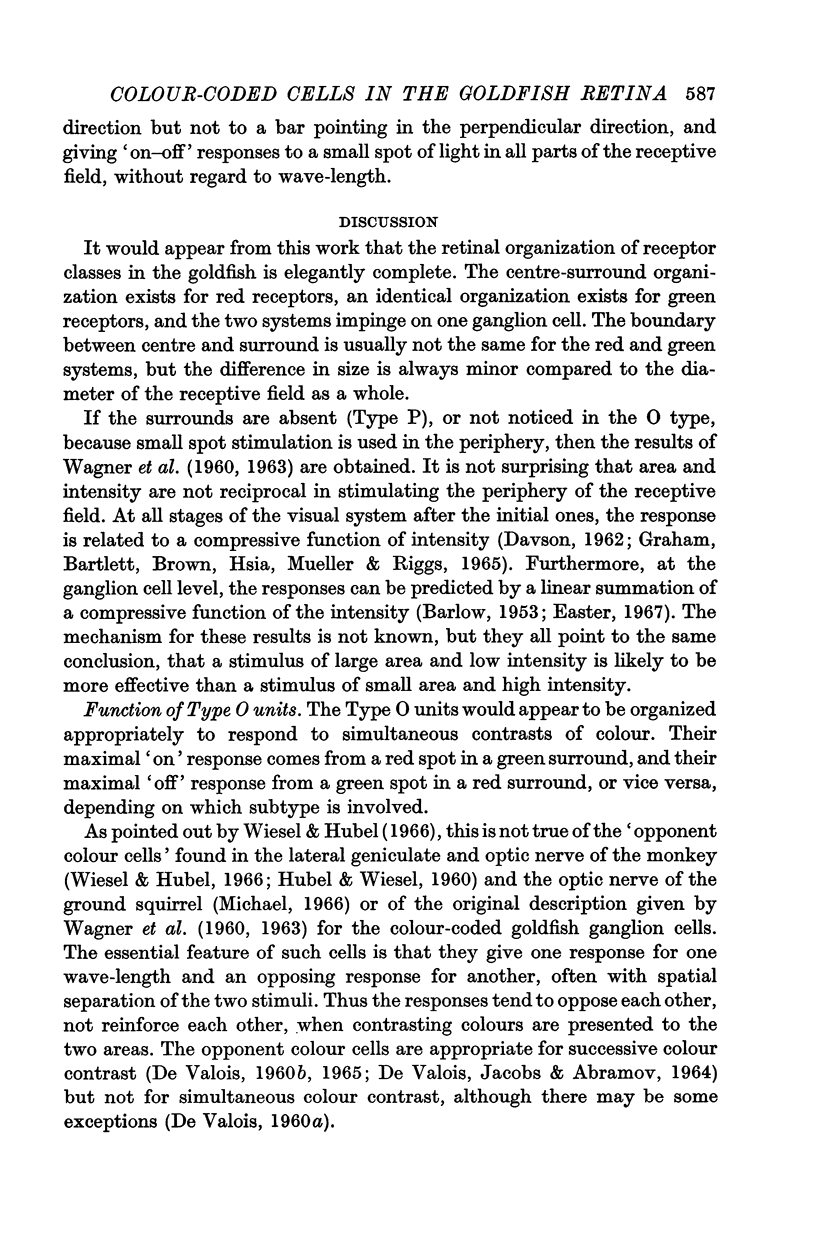
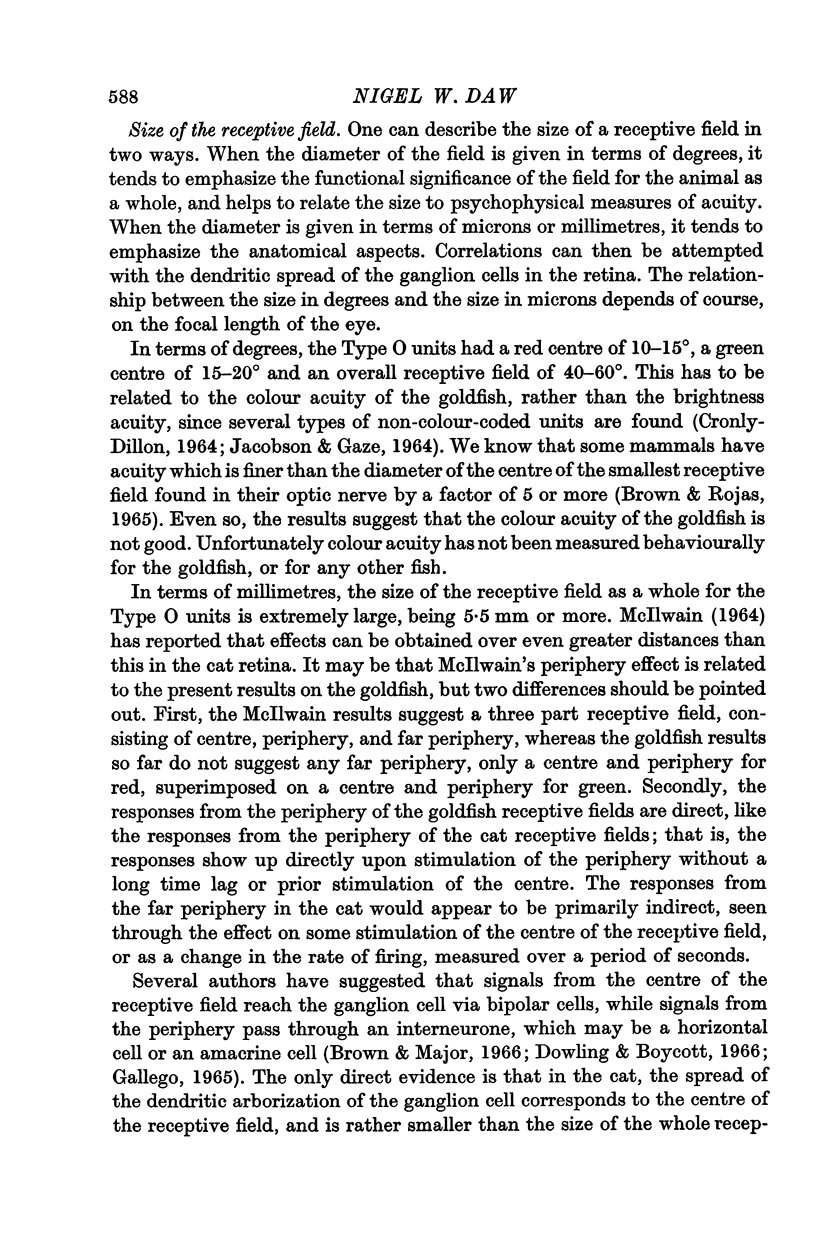
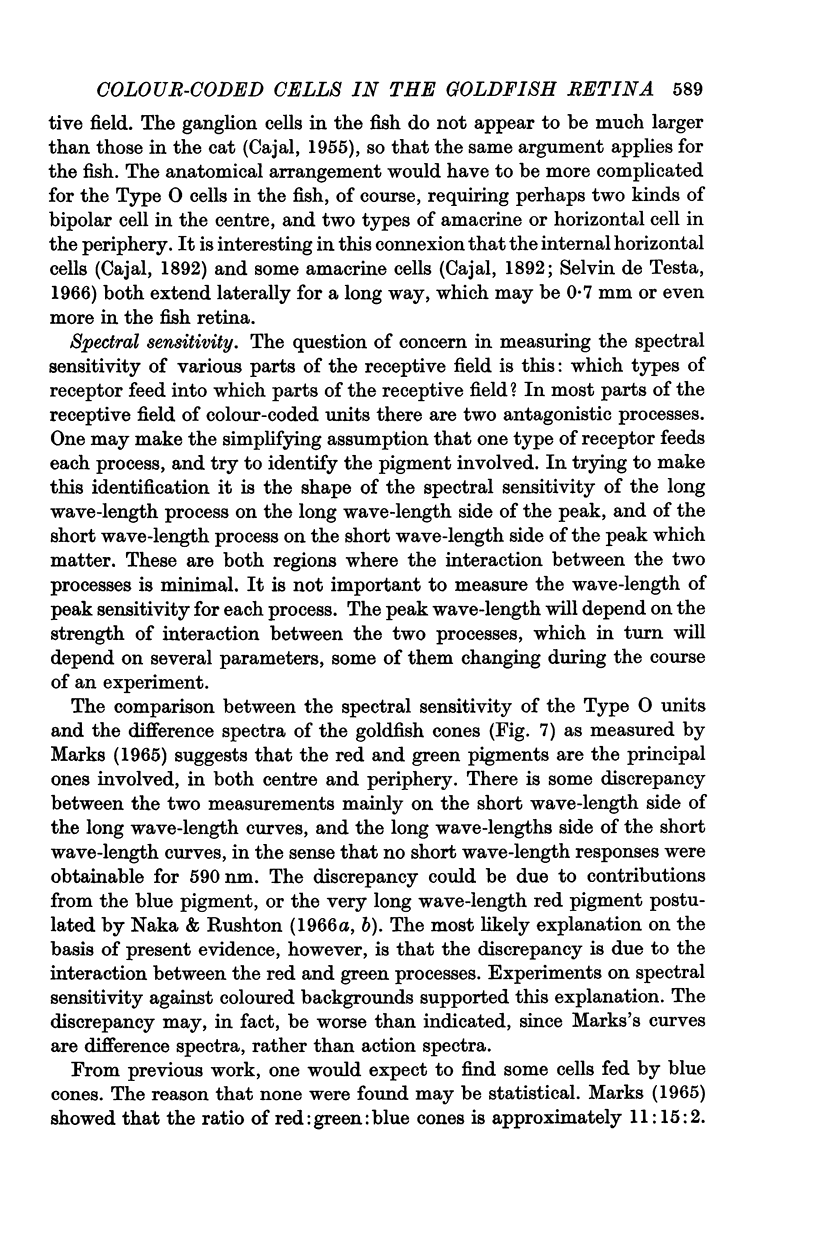
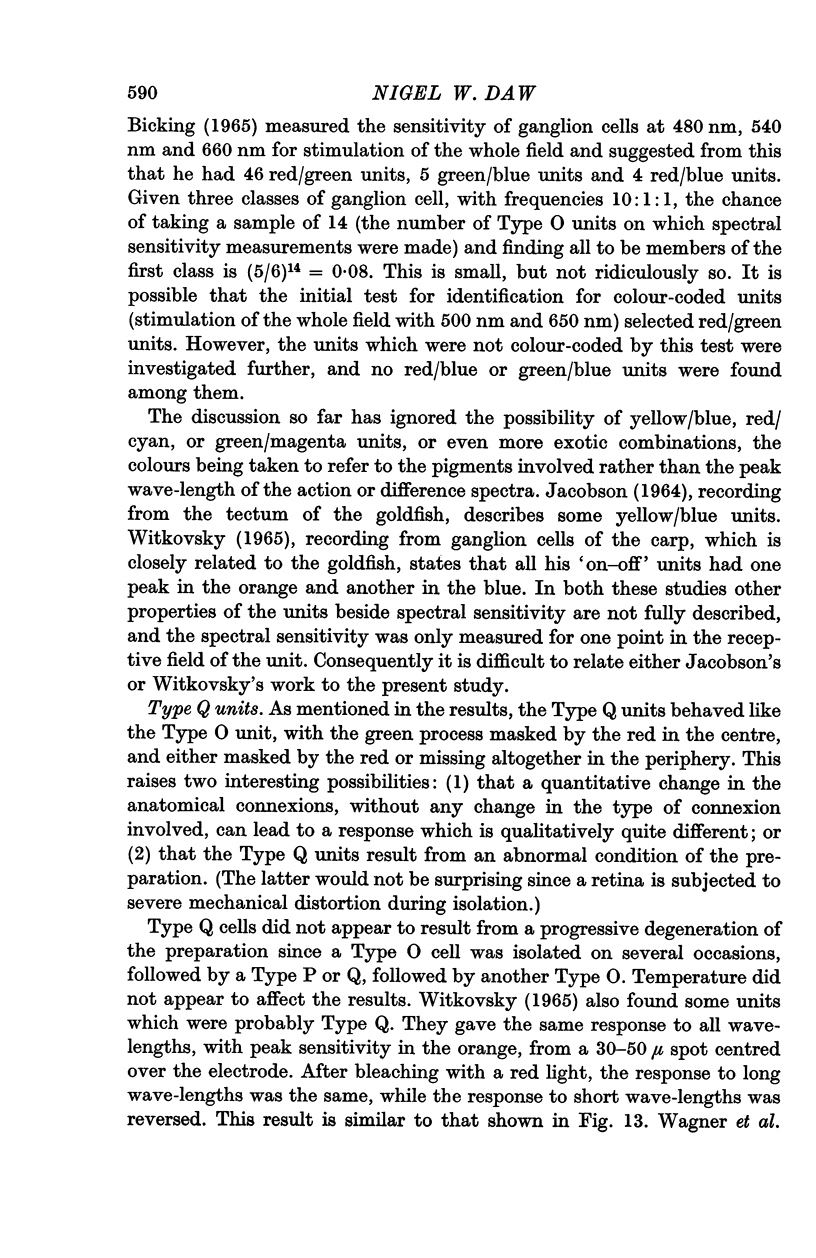
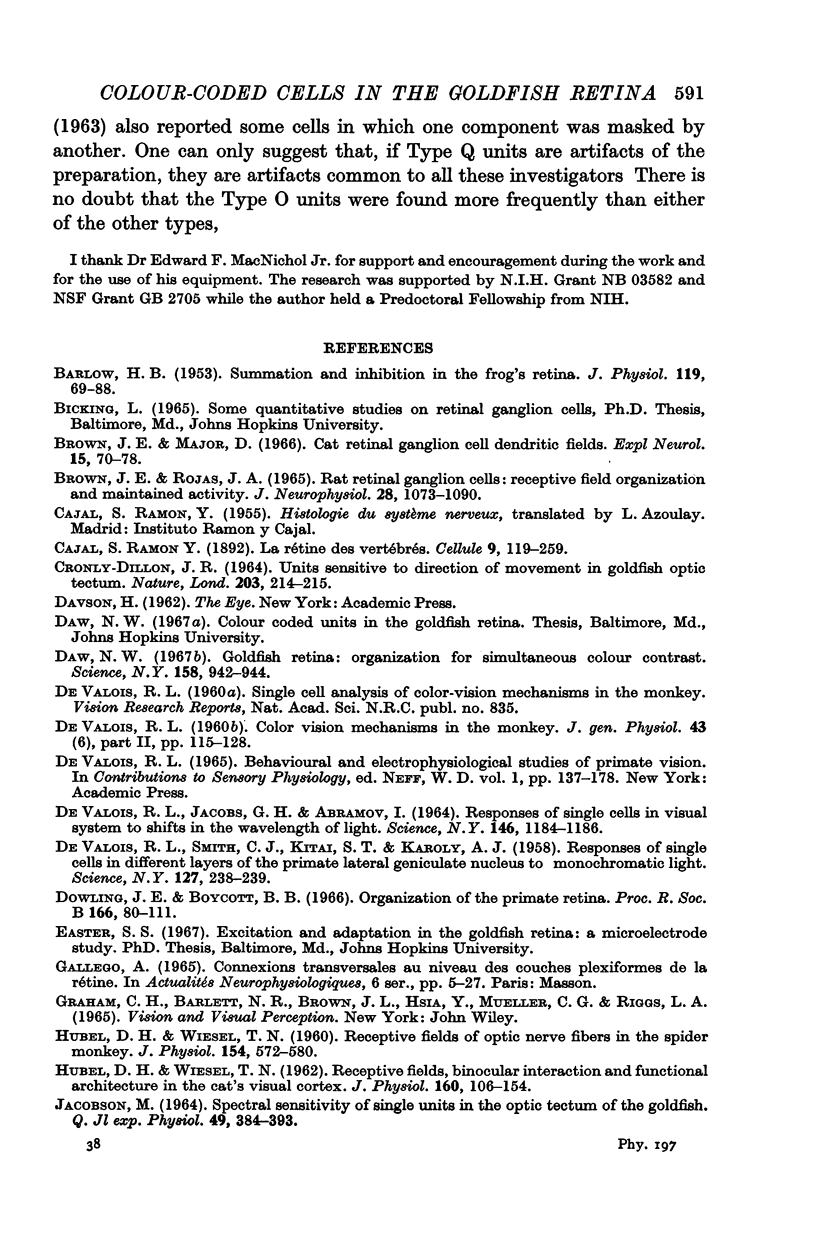
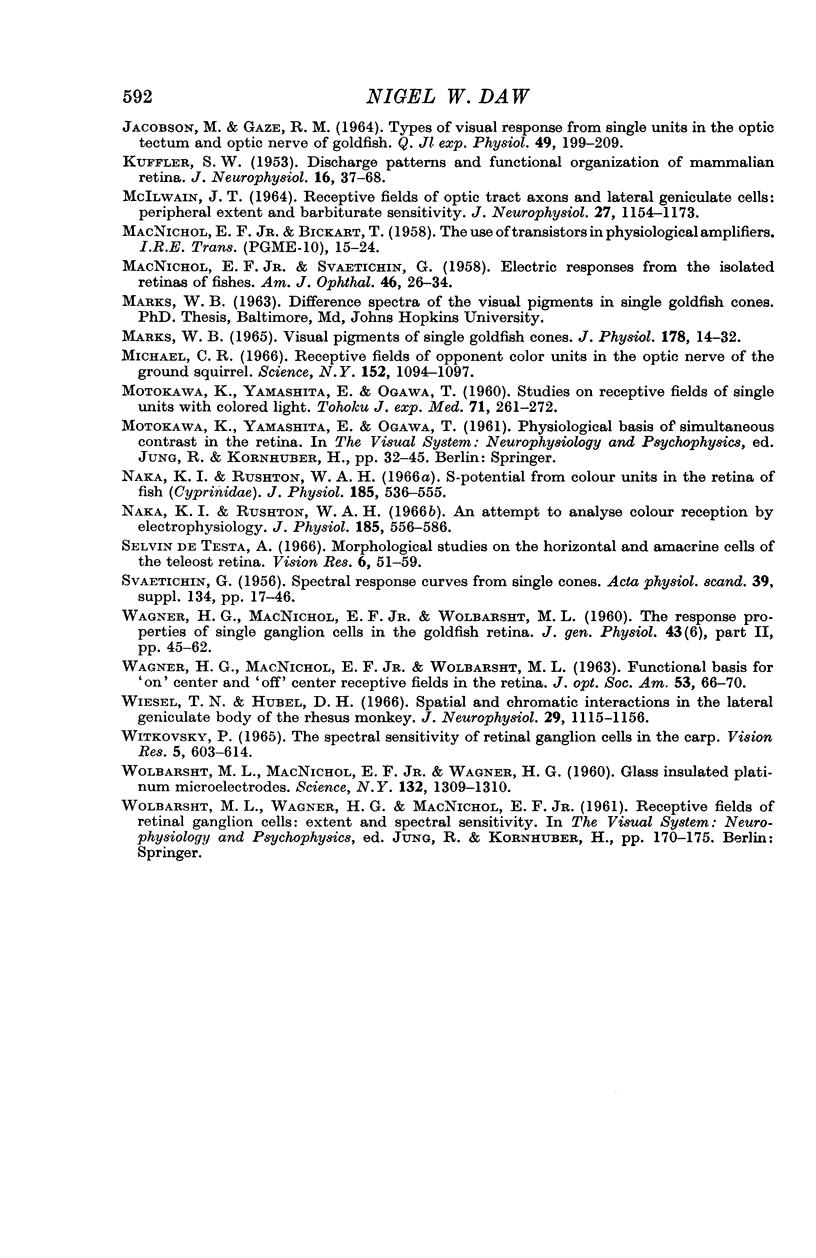
Selected References
These references are in PubMed. This may not be the complete list of references from this article.
- BARLOW H. B. Summation and inhibition in the frog's retina. J Physiol. 1953 Jan;119(1):69–88. doi: 10.1113/jphysiol.1953.sp004829. [DOI] [PMC free article] [PubMed] [Google Scholar]
- Brown J. E., Major D. Cat retinal ganglion cell dendritic fields. Exp Neurol. 1966 May;15(1):70–78. doi: 10.1016/0014-4886(66)90035-5. [DOI] [PubMed] [Google Scholar]
- Brown J. E., Rojas J. A. Rat retinal ganglion cells: receptive field organization and maintained activity. J Neurophysiol. 1965 Nov;28(6):1073–1090. doi: 10.1152/jn.1965.28.6.1073. [DOI] [PubMed] [Google Scholar]
- CRONLY-DILLON J. R. UNITS SENSITIVE TO DIRECTION OF MOVEMENT IN GOLDFISH OPTIC TECTUM. Nature. 1964 Jul 11;203:214–215. doi: 10.1038/203214a0. [DOI] [PubMed] [Google Scholar]
- DE VALOIS R. L. Color vision mechanisms in the monkey. J Gen Physiol. 1960 Jul;43(6):115–128. doi: 10.1085/jgp.43.6.115. [DOI] [PMC free article] [PubMed] [Google Scholar]
- DE VALOIS R. L., SMITH C. J., KITAI S. T., KAROLY A. J. Response of single cells in monkey lateral geniculate nucleus to monochromatic light. Science. 1958 Jan 31;127(3292):238–239. doi: 10.1126/science.127.3292.238. [DOI] [PubMed] [Google Scholar]
- DEVALOIS R. L., JACOBS G. H., ABRAMOV I. RESPONSES OF SINGLE CELLS IN VISUAL SYSTEM TO SHIFTS IN THE WAVELENGTH OF LIGHT. Science. 1964 Nov 27;146(3648):1184–1186. doi: 10.1126/science.146.3648.1184. [DOI] [PubMed] [Google Scholar]
- Daw N. W. Goldfish retina: organization for simultaneous color contrast. Science. 1967 Nov 17;158(3803):942–944. doi: 10.1126/science.158.3803.942. [DOI] [PubMed] [Google Scholar]
- Dowling J. E., Boycott B. B. Organization of the primate retina: electron microscopy. Proc R Soc Lond B Biol Sci. 1966 Nov 15;166(1002):80–111. doi: 10.1098/rspb.1966.0086. [DOI] [PubMed] [Google Scholar]
- HUBEL D. H., WIESEL T. N. Receptive fields of optic nerve fibres in the spider monkey. J Physiol. 1960 Dec;154:572–580. doi: 10.1113/jphysiol.1960.sp006596. [DOI] [PMC free article] [PubMed] [Google Scholar]
- HUBEL D. H., WIESEL T. N. Receptive fields, binocular interaction and functional architecture in the cat's visual cortex. J Physiol. 1962 Jan;160:106–154. doi: 10.1113/jphysiol.1962.sp006837. [DOI] [PMC free article] [PubMed] [Google Scholar]
- JACOBSON M., GAZE R. M. TYPES OF VISUAL RESPONSE FROM SINGLE UNITS IN THE OPTIC TECTUM AND OPTIC NERVE OF THE GOLDFISH. Q J Exp Physiol Cogn Med Sci. 1964 Apr;49:199–209. doi: 10.1113/expphysiol.1964.sp001720. [DOI] [PubMed] [Google Scholar]
- JACOBSON M. SPECTRAL SENSITIVITY OF SINGLE UNITS IN THE OPTIC TECTUM OF THE GOLDFISH. Q J Exp Physiol Cogn Med Sci. 1964 Oct;49:384–393. doi: 10.1113/expphysiol.1964.sp001744. [DOI] [PubMed] [Google Scholar]
- KUFFLER S. W. Discharge patterns and functional organization of mammalian retina. J Neurophysiol. 1953 Jan;16(1):37–68. doi: 10.1152/jn.1953.16.1.37. [DOI] [PubMed] [Google Scholar]
- MACNICHOL E. J., SVAETICHIN G. Electric responses from the isolated retinas of fishes. Am J Ophthalmol. 1958 Sep;46(3 Pt 2):26–46. doi: 10.1016/0002-9394(58)90053-9. [DOI] [PubMed] [Google Scholar]
- MARKS W. B. VISUAL PIGMENTS OF SINGLE GOLDFISH CONES. J Physiol. 1965 May;178:14–32. doi: 10.1113/jphysiol.1965.sp007611. [DOI] [PMC free article] [PubMed] [Google Scholar]
- MCILWAIN J. T. RECEPTIVE FIELDS OF OPTIC TRACT AXONS AND LATERAL GENICULATE CELLS: PERIPHERAL EXTENT AND BARBITURATE SENSITIVITY. J Neurophysiol. 1964 Nov;27:1154–1173. doi: 10.1152/jn.1964.27.6.1154. [DOI] [PubMed] [Google Scholar]
- MOTOKAWA K., YAMASHITA E., OGAWA T. Studies on receptive fields of single units with colored lights. Tohoku J Exp Med. 1960 Feb 25;71:261–272. doi: 10.1620/tjem.71.261. [DOI] [PubMed] [Google Scholar]
- Michael C. R. Receptive fields of opponent color units in the optic nerve of the ground squirrel. Science. 1966 May 20;152(3725):1095–1097. doi: 10.1126/science.152.3725.1095. [DOI] [PubMed] [Google Scholar]
- Naka K. I., Rushton W. A. An attempt to analyse colour reception by electrophysiology. J Physiol. 1966 Aug;185(3):556–586. doi: 10.1113/jphysiol.1966.sp008002. [DOI] [PMC free article] [PubMed] [Google Scholar]
- Naka K. I., Rushton W. A. S-potentials from colour units in the retina of fish (Cyprinidae). J Physiol. 1966 Aug;185(3):536–555. doi: 10.1113/jphysiol.1966.sp008001. [DOI] [PMC free article] [PubMed] [Google Scholar]
- SVAETICHIN G. Spectral response curves from single cones. Acta Physiol Scand Suppl. 1956;39(134):17–46. [PubMed] [Google Scholar]
- Selvín de Testa A. Morphological studies on the horizontal and amacrine cells of the teleost retina. Vision Res. 1966 Feb;6(1):51–59. doi: 10.1016/0042-6989(66)90013-7. [DOI] [PubMed] [Google Scholar]
- WAGNER H. G., MACNICHOL E. F., Jr, WOLBARSHT M. L. Functional basis for "on"-center and "off"-center receptive fields in the retina. J Opt Soc Am. 1963 Jan;53:66–70. doi: 10.1364/josa.53.000066. [DOI] [PubMed] [Google Scholar]
- Wiesel T. N., Hubel D. H. Spatial and chromatic interactions in the lateral geniculate body of the rhesus monkey. J Neurophysiol. 1966 Nov;29(6):1115–1156. doi: 10.1152/jn.1966.29.6.1115. [DOI] [PubMed] [Google Scholar]
- Witkovsky P. The spectral sensitivity of retinal ganglion cells in the carp. Vision Res. 1965 Dec;5(11):603–614. doi: 10.1016/0042-6989(65)90034-9. [DOI] [PubMed] [Google Scholar]
- Wolbarsht M. L., Macnichol E. F., Jr, Wagner H. G. Glass Insulated Platinum Microelectrode. Science. 1960 Nov 4;132(3436):1309–1310. doi: 10.1126/science.132.3436.1309. [DOI] [PubMed] [Google Scholar]


